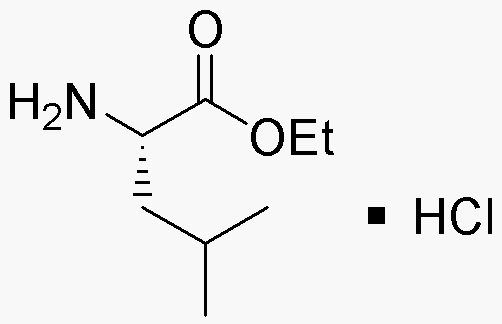L-Leucine ethyl ester hydrochloride is widely utilized in research focused on:
- Protein Synthesis: This compound serves as a building block for proteins, making it essential in studies related to muscle growth and recovery, particularly in sports nutrition.
- Pharmaceutical Development: It is used in the formulation of various medications aimed at enhancing muscle metabolism and promoting anabolic processes, beneficial for patients with muscle-wasting conditions.
- Biochemical Research: Researchers leverage its properties to investigate metabolic pathways and the role of amino acids in cellular functions, providing insights into health and disease.
- Food Industry: The compound is incorporated into dietary supplements and functional foods, appealing to health-conscious consumers looking for muscle support and recovery solutions.
- Animal Nutrition: It is also applied in veterinary medicine to improve the growth and feed efficiency of livestock, addressing the needs of farmers seeking to enhance animal health and productivity.
General Information
Properties
Safety and Regulations
Applications
L-Leucine ethyl ester hydrochloride is widely utilized in research focused on:
- Protein Synthesis: This compound serves as a building block for proteins, making it essential in studies related to muscle growth and recovery, particularly in sports nutrition.
- Pharmaceutical Development: It is used in the formulation of various medications aimed at enhancing muscle metabolism and promoting anabolic processes, beneficial for patients with muscle-wasting conditions.
- Biochemical Research: Researchers leverage its properties to investigate metabolic pathways and the role of amino acids in cellular functions, providing insights into health and disease.
- Food Industry: The compound is incorporated into dietary supplements and functional foods, appealing to health-conscious consumers looking for muscle support and recovery solutions.
- Animal Nutrition: It is also applied in veterinary medicine to improve the growth and feed efficiency of livestock, addressing the needs of farmers seeking to enhance animal health and productivity.
Documents
Safety Data Sheets (SDS)
The SDS provides comprehensive safety information on handling, storage, and disposal of the product.
Product Specification (PS)
The PS provides a comprehensive breakdown of the product’s properties, including chemical composition, physical state, purity, and storage requirements. It also details acceptable quality ranges and the product's intended applications.
Certificates of Analysis (COA)
Search for Certificates of Analysis (COA) by entering the products Lot Number. Lot and Batch Numbers can be found on a product’s label following the words ‘Lot’ or ‘Batch’.
*Catalog Number
*Lot Number
Certificates Of Origin (COO)
This COO confirms the country where the product was manufactured, and also details the materials and components used in it and whether it is derived from natural, synthetic, or other specific sources. This certificate may be required for customs, trade, and regulatory compliance.
*Catalog Number
*Lot Number
Safety Data Sheets (SDS)
The SDS provides comprehensive safety information on handling, storage, and disposal of the product.
DownloadProduct Specification (PS)
The PS provides a comprehensive breakdown of the product’s properties, including chemical composition, physical state, purity, and storage requirements. It also details acceptable quality ranges and the product's intended applications.
DownloadCertificates of Analysis (COA)
Search for Certificates of Analysis (COA) by entering the products Lot Number. Lot and Batch Numbers can be found on a product’s label following the words ‘Lot’ or ‘Batch’.
*Catalog Number
*Lot Number
Certificates Of Origin (COO)
This COO confirms the country where the product was manufactured, and also details the materials and components used in it and whether it is derived from natural, synthetic, or other specific sources. This certificate may be required for customs, trade, and regulatory compliance.


